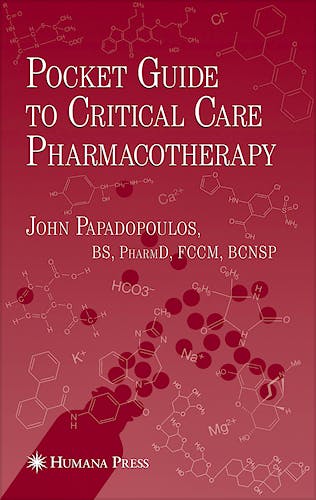

No hay productos en el carrito



Pocket Guide to Critical Care Pharmacotherapy
Papadopoulos, John
1ª Edición Enero 2008
Inglés
Tapa blanda
208 pags
1100 gr
null x null x null cm
ISBN 9781934115459
Editorial SPRINGER
Because critical care medicine is a cutting-edge medical field that is highly evidence-based, studies are continuously published altering the approach to patient-care. This creates a challenge for many clinicians to keep abreast of the latest data. Pocket Guide to Critical Care Pharmacotherapy serves as a bedside medical reference, providing the unique element of supplying a step-by-step design that will guide clinicians in giving their patient optimal, evidence-based care. The text provides practical points based on both real patient-care experience and review of current medical literature while providing guidance to all critical care clinicians. By covering the most common ailments observed in critically ill medical patients and using an algorithmic, easy-to-follow, step-by-step approach focusing on pharmacotherapeutics clinicians with varying degrees of training will be able to follow along. Additionally, assessment tools (e.g., sedation assessment), preventative strategies (e.g., stress-related mucosal damage prophylaxis), drug-induced disease states, and pharmacological pearls (e.g. neuromuscular blockade reversal, adverse effects of blood transfusions, and propylene glycol content of various medications) are provided, along with up-to-date references and web-links for many disease states so clinicians who want to review the available literature are able to do so. The book is easy to reference in an emergency or ICU setting because individual chapters utilize one table per disease state. Most other books available do not emphasis specific disease therapeutics – Pocket Guide to Critical Care Pharmacotherapy offers very specific context for the therapeutic treatment and management of a disease. No clinician working in pharmacotherapy should be without this pocket reference.
Written for:
Critical care doctors, ICU doctors, physicians, pharmacists, physician assistants, and nurse practitioners as well as fellows, residents, interns, and students of all the above disciplines
Table of Contents:
Advance cardiac life support (ACLS) (tables 1-13)
1. Tachyarrhythmias, bradyarrhythmias, asystole, anaphylaxis
Cardiovascular (tables 14-35)
1. Hypertensive emergencies
2. Venous thromboembolism
3. Cerebrovascular accidents
1. tPA protocols
2. Blood pressure management
3. NIH stroke scales
4. Management of intracranial hemorrhage
4. Shock
1. Cardiogenic shock
5. Drug-induced torsades
6. Reversal of fibrinolytics, anticoagulants, and warfarin
7. Catecholamine extravasation
8. Acute coronary syndrome
1. ST-segment elevation myocardial infarction
2. Non ST-segment elevation myocardial infarction
3. Unstable angina
9. Management of right-sided infarction
Critical care issues (tables 36-49)
1. Sedation
1. Pharmacotherapy
2. Assessment scales
2. Pain management
3. Delirium
1. Assessment methods
4. Neuromuscular blockade
5. Malignant hyperthermia
6. Anemia of critical illness
7. Drug-induced fever
8. Oral medications that should not be crushed
9. Management of anaphylaxis
10. Stress-related mucosal damage prophylaxis
11. Deep vein thrombosis prophylaxis
Dermatological disorders (table 50)
1. Drug-induced skin reactions
Endocrinologic disorders (tables 51-53)
1. Diabetic ketoacidosis
2. Hyperosmolar non-ketotic states
3. Thyroid storm
4. Myxedema
Gastrointestinal disorders (tables 54-57)
1. Non-variceal upper gastrointestinal bleeds
2. Diarrhea
3. Cirrhosis
1. Ascites
2. Hepatic encephalopathy
3. Spontaneous bacterial peritonitis
4. Variceal bleeds
5. Hepato-renal syndrome
4. Drug-induced liver disease
Hematological disorders (tables 58-60)
1. Drug-induced hematological disorders
2. Methemoglobinemia
3. Heparin-induced thrombocytopenia
Infectious Diseases (tables 61-64)
1. Hospital-acquired/ventilator-associated pneumonia
1. Clinical pulmonary infection score determination
2. Sepsis/septic shock
1. Activated protein C
2. Corticosteroids
3. Glycemic control
Neurological disorders (table 65)
1. Status epilepticus
Nutrition (tables 66-69)
1. Assessment
2. Parenteral
3. Enteral
4. Considerations in organ failure
5. Prokinetics
Psychiatric disorders (tables 70-72)
1. Alcohol withdrawal
1. Delirium tremens
2. Neuroleptic malignant syndrome
3. Serotonin syndrome
Pulmonary disorders (tables 73-75)
1. Status asthmaticus
2. Chronic obstructive pulmonary disease
3. Drug-induced pulmonary disease
Renal disorders (tables 76-92)
1. Contrast-induced nephropathy
2. Acute renal failure
3. Uremic bleeds
4. Drug-induced renal disease
5. Acid-base disorders
6. Diuretic resistance
7. Hyper/hypocalcemia
8. Hyper/hypokalemia
9. Hyper/hypomagnesemia
10. Hyper/hyponatremia
11. Hyper/hypophosphatemia
12. Drug dosing in patients on continuous renal replacement therapy
© 2026 Axón Librería S.L.
2.149.0